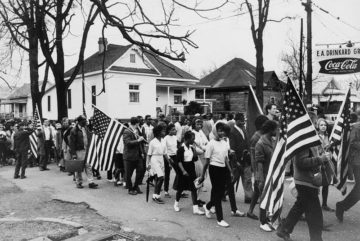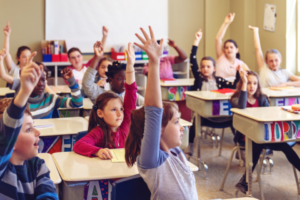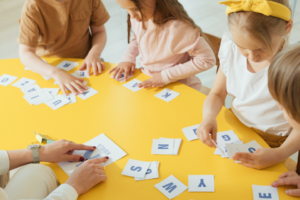
Teaching Youth about the Civil Rights Movement and the Children’s Crusade
 Teaching students about Martin Luther King, Jr., the Civil Rights Movement, and the Children’s Crusade can be some of the most challenging and purposeful topics for any teacher. Issues of racial identity, peaceful protest, and social justice are a lot to tackle. But, they can be powerful and rewarding if they are presented to students in an age-appropriate way that honors student reflection on these topics and helps them to connect them to their own lives. This article discusses the history of the Children’s Crusade of 1963, a juncture at which youth participated in the American Civil Rights Movement. Because this is a complex and not entirely peaceful topic at junctures, it may be best suited for middle and high school students who have been carefully introduced to the concept of peaceful civil disobedience and the conflicts that sometimes accompany it. Suggestions for related educational activities and links to helpful websites are also included below. These are important topics to consider covering in January in honor of Martin Luther King, Jr. Day, in February for African American History Month, or at any time of the school year.
Teaching students about Martin Luther King, Jr., the Civil Rights Movement, and the Children’s Crusade can be some of the most challenging and purposeful topics for any teacher. Issues of racial identity, peaceful protest, and social justice are a lot to tackle. But, they can be powerful and rewarding if they are presented to students in an age-appropriate way that honors student reflection on these topics and helps them to connect them to their own lives. This article discusses the history of the Children’s Crusade of 1963, a juncture at which youth participated in the American Civil Rights Movement. Because this is a complex and not entirely peaceful topic at junctures, it may be best suited for middle and high school students who have been carefully introduced to the concept of peaceful civil disobedience and the conflicts that sometimes accompany it. Suggestions for related educational activities and links to helpful websites are also included below. These are important topics to consider covering in January in honor of Martin Luther King, Jr. Day, in February for African American History Month, or at any time of the school year.
The Civil Rights Movement
The Civil Rights Movement in America of the 50’s and 60’s focused on ending racial segregation and the enduring widespread post-slavery discrimination against African Americans, especially in the Southern U.S. States. Participants in the movement also specifically sought (and won) legal recognition and protections for African Americans and their constitutional rights under U.S. federal law. Martin Luther King Jr., born in 1929, was a leader in the movement as well as a minister. He believed in practicing non-violent disobedience and peaceful protest and was heavily inspired by the Indian leader, Mahatma Gandhi, who previously extolled, practiced, and embodied these virtues during the Indian independence movement. Martin Luther King Jr. was assassinated in 1968 by a segregationist.
Birmingham, Alabama
Birmingham, Alabama became central and important to the Civil Rights Movement and to Martin Luther King Jr. before the Children’s Crusade. Birmingham practiced severe segregation throughout the city and, for example, African Americans were discriminated from many job options and were only allowed to enter certain spaces or attend certain events and festivals on “colored days.” In 1963, Civil Rights leaders including Martin Luther King Jr. led members of the local community in nonviolent protests in an attempt to pressure local businesses to desegregate. Many protestors were arrested and in mid-April King penned his famous and lengthy “Letter from a Birmingham Jail,” in which he writes, in part, “one day the South will recognize its real heroes…They will be the young high school and college students, the young ministers of the gospel and a host of their elders, courageously and nonviolently sitting in at lunch counters and willingly going to jail for conscience’ sake…”
The Children’s Crusade
The Children’s Crusade was suggested by Civil Rights activist James Bevel. Children in Birmingham who had witnessed their parents’ protests were soon trained in non-violent disobedience themselves. Biography.com explains that “while many parents and Civil Rights leaders were cautious about involving young people in the protests, it turned out that the brave actions of these children helped make lasting change in Birmingham at a key turning point in the movement.” Whether or not students and youth should be involved in political protests is an excellent topic for school debate and can be tied into the related educational activities mentioned below.
On May 2nd of 1963, children marched out of the 16th Street Baptist church in Birmingham in waves, with a goal of peacefully travelling through town to speak with the mayor. The young protestors were, in turn, arrested and even treated violently with water cannons and threatened with police dogs. Protestors gathered outside of the jail where many young people were held and as images of the adult and youth marches in Birmingham and arrests of peaceful protestors spread throughout the nation, pressure mounted on the local government to respond to the protestors’ wishes. By May 10, city officials and Civil Rights leaders came to a desegregation agreement. While all of the protestors were freed, racial discrimination and violence against African Americans continued in Birmingham and throughout the United States. The Civil Rights Movement resulted in the passage of major federal anti-discrimination legislation, including The Civil Rights Act of 1964, which banned discrimination based on race, color, religion, sex, or national origin in employment, voting, schools, and public spaces, as well as The Voting Rights Act, The Immigration and Nationality Services Act, and The Fair Housing Act.
After learning about the Civil Rights Movement and the Children’s Crusade, students can discuss the relevance of these events to their own lives. Debating current events, learning about practicing tolerance in schools, writing about their own thoughts on non-violence, and designing protest posters about a school or local community issue they feel strongly about are all examples of powerful possible correlated activities. BrainPop Educators shares a “U.S. History Lesson Plan: Exploring Cause and Effect,” for grades three through twelve that encourages students to study cause and effect in a period of U.S. History, such as the Civil Rights Era. Teaching Tolerance has created an excellent kit called “Mighty Times: The Children’s March” which comes with nine lesson plans for grades six to eight and nine to twelve along with a film about the children’s crusade that teachers can order for free. Edsitement, a program of the National Endowment for the Humanities, offers an engaging lesson on Martin Luther King Jr.’s philosophy of non-violence and the National Education Association offers numerous Martin Luther King, Jr. Day resources here. Teaching students about the desegregation of America and the enduring legacy of peaceful civil disobedience can help them to better understand our country and, quite possibly, themselves.
Written by Julia Travers
Contact us today to learn more about how our tutors can help your child learn and grow!



